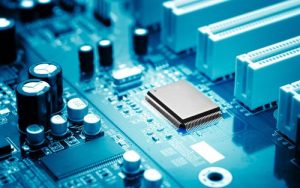Key Takeaways
- Most integrated circuits (ICs) contain millions of tiny transistors, diodes, resistors, capacitors, and other components in their internal architecture.
- Integrated circuits are microelectronic circuits fabricated as a single unit on a semiconductor substrate and can perform a variety of operations as designed.
- Mixed-signal ICs utilize both analog and digital design principles to handle both types of signal processing.
- The IC 741 is commonly used in applications involving operational amplifiers.
Integrated Circuits in Modern Electronics
Integrated circuits, often called chips, are essential components in any electronic device. They can function as amplifiers, oscillators, counters, voltage regulators, timers, and memory, effectively replacing discrete component-based circuits. Miniaturization is one of the key advantages of ICs.
What Is an Integrated Circuit?
Integrated circuits are microelectronic circuits fabricated as a single unit on a semiconductor substrate, designed to perform specific functions.

Components of an Integrated Circuit
ICs are composed of various basic blocks, depending on their specific application. These include millions of tiny transistors, diodes, resistors, capacitors, and other components embedded within their internal structure.
Size and Composition
In ICs, all components are embedded within the chip and interconnected through the semiconductor substrate, copper, or other materials like platinum or gold. These circuits are so small that they are often referred to as microchips. Some ICs occupy just a few square millimeters.
Functions of Integrated Circuits
Typically, silicon semiconductors are used to fabricate ICs. The embedded components, such as resistors, capacitors, diodes, and transistors, allow the IC to function as intended. ICs can perform various operations such as waveform generation (oscillators), voltage amplification (amplifiers), pattern generation (counters), and binary operations (logic gates).
- 555 Timer: Functions as timing circuits and is used in oscillators, pulse generation, timers, etc.
- 741/LM 324: Functions as operational amplifiers, enabling mathematical operations.
- 78XX: Used for voltage regulation. For example:
- 7805 provides +5V
- 7905 provides -5V
- 7812 provides +12V
- 7912 provides -12V
- 74XX: Represents logic gates. For example:
- 7400 is a NAND gate
- 7404 is a NOT gate
- 7408 is an AND gate
-
Types of Integrated Circuits
ICs can be classified based on their fabrication technology, integration technology, signal processing nature, and packaging style.
Based on Signal Type
- Digital ICs: Operate on discrete signals or binary data. Examples include flip-flops, logic gates, and multiplexers.
- Analog ICs: Handle continuous signals. Examples include amplifiers, sensors, and oscillators.
Mixed-signal ICs: Combine both analog and digital design principles for comprehensive signal processing.
Based on Number of Transistors
With advancements in integration technology, ICs now embed over 10 million transistors on a single chip. IC technology can be classified as follows:
-
- Small Scale Integration (SSI): 1-100 transistors.
- Medium Scale Integration (MSI): 100-1,000 transistors.
- Large Scale Integration (LSI): 1,000-10,000 transistors.
- Very Large Scale Integration (VLSI): 10,000-1 million transistors.
- Ultra Large Scale Integration (ULSI): 1 million-10 million transistors.
- Giant Large Scale Integration (GLSI): Above 10 million transistors.
Advantages and Disadvantages of Integrated Circuits
Advantages
- Small size
- Complex circuits can be fabricated, improving performance
- More reliable than discrete component-based circuits
- Lower power consumption
